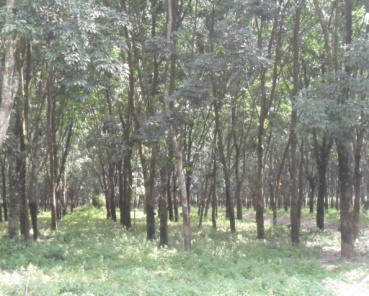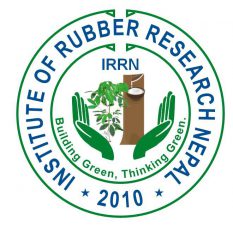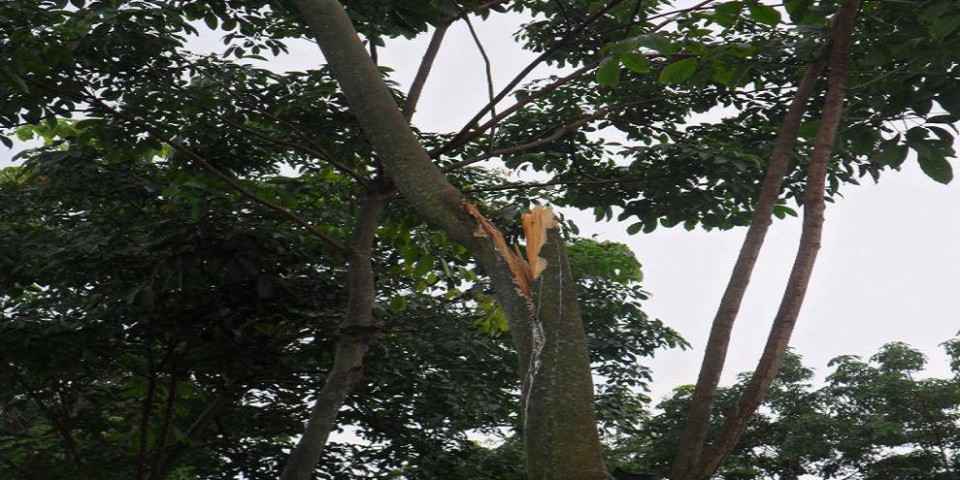Jun 25, 2015
Writer: Tilak B. Bhandari (Rubber Scientist)
Natural Rubber was first introduced to Singapore in 1877 and then it became commercial planting material in Malaysia which was originated from 22 seedlings. Today, rubber industry is the second largest industry in the world after iron and steel. It is one of the most important raw materials that is important for transportation, industry, defense and medical field. Used for manufacture of more than 40,000 products including 400 medical devices. It is a green material for the current era. Based on 22 years research study of Gorakhkali Rubber Industry Ltd. with the joint venture, Sudha Falrus Pvt. Ltd, Sanischare-1,Jhapa set up 1989 Pioneer Pilot Project. 15 years of yield performance Hevea cultivation is highly potential in Eastern Terai districts of Jhapa, Morang, Sunsari and lower parts of Ilam.
Picture 1: Sanischare-1, Jhapa Farm

The production so far is 200 ton per year while consumption is 12,000 metric ton (US $ 45 million per year) in Nepal. It has been estimated that by 2020 AD, the demand of Natural Rubber is expected to cross 20,000 metric ton per year.
- Rubber planting was introduced in the early 1970s but never achieved a great success. The current boom in rubber is being fueled by a demand from rubber market, particularly Gorakhkali Rubber Udyog, individual farmer interest, private companies, cooperatives and local forestry user groups. The IRJR-Nepal (www.irjr-n.org) has targeted 15,000 hectares of rubber plantation by 2022 with close coordination and cooperation of Govt. of Nepal, local stakeholders and multinational agencies. Natural Rubber is Multi Products industrial Cash Crop which is obtained from the latex of Hevea brasiliensis, Native of Brazil.
- Gestation period of 6-7 years, Economic life around 25 yrs,
- Potential area 15,000 hectares in Jhapa, Morang, Sunsari and Ilam districts.
- Yield per hectare 1500 kilograms (3 to 4 lakh net profit per hectare per year).
- Natural Rubber is called “White Gold”. Current international market price is around average 4 dollars per kg.
Why Natural Rubber farming in Nepal?
- A huge industrial demand- Around 6 arab rupees Nepal importing in 2012
- Provide high and regular income to the farmers 3-4 lakhs per hectare per year
- Generate stable rural employment-25,000 people
- Low investment-3 lakhs per hectare (1-7 years)
- Long period of productivity-25 years
- High volume of tropical rubber wood- 8800 cubic feet after 32 years
- High cost of synthetic rubber
- Has a wide range of adaptability
- Allows intercropping of food and cash crops for higher farmers income
- Plantationlabor cost in Nepal is cheaper than the emerging Asia
- Adhering of new technology into Nepal and Carbon Trading
- 1.7 million Automobile vehicles are running in Nepal’s road as of 2014.
Picture 2 : Chief Secretary Leela M.Paudel

Benefits of Rubber Planting in Nepal
- Dry Rubber25,000 Mt ton/ha/ annum equivalent $100 million.
- Gainful self-employment (25,000 persons directly and indirectly) and sustainable livelihood for youth, marginal people and reduction of poverty.
- Ancillary income through honey (150/kg/ha) (1500 MT/25 years = $ 3.75 million), rubber seeds (150/kg/ha) (5000 Mt/ = $1,375,000), tropical rubber wood (250 cubic feet/ha) (2 million cu. ft after completed one cycle =150 million dollars) and orchid farming (as a dollar earner).
- Purify atmosphere through carbon sequestration. (Environmental Development) 1 ton of Carbon trading around US$ 15 per ton ($6,750 per hectare bonus payment for the farmers).
- Rubber tree has almost all the attributes of a forest species.
- It is an eco-tourism project
- Potential for export of NR rubber goods.
Issues
Growth and expansion is marred by political, social and economic barriers.
Total area under cultivation is 700 hectares
Lack of incentives from the Government of Nepal
Lack of Dissemination of market and price information
Lack of management, education and training for farmers
Youths are motivated to migrate to the overseas due to higher incentives.
Major Findings
Effective rates as “very high to high” by beneficiaries.
Growers expressed “high value crop and satisfaction”.
Improved the socio-economic status of growers enhanced 200 to 500%.
This article has been submitted to the Hello Sarkar proposal to Prime Minister Office, Government of Nepal on May 5, 2012 to provide funding of 50% and other costs will be shared by IRJR-Nepal 30% and local stakeholders 20% cost investment plantation 15,000 hectare within 10 years (2012 to 2022).

